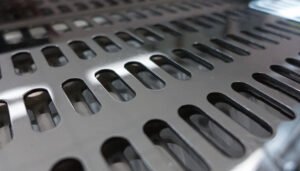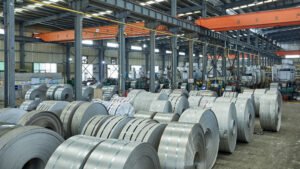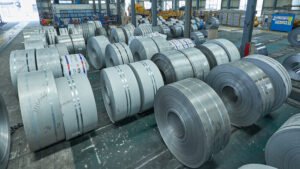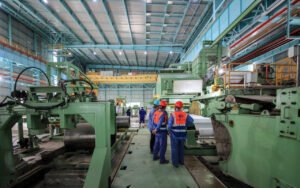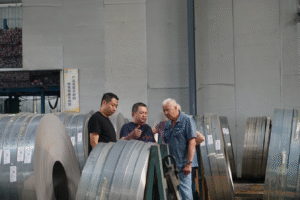Stainless Steel Coil 304: The Unquestionable Workhorse of Modern Industry
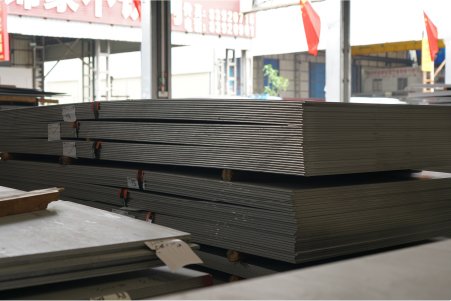
Are you struggling to find a material that balances cost, performance, and reliability for your manufacturing needs? Choosing the wrong alloy can lead to premature failure, budget overruns, and damage to your reputation. Stainless steel coil 304 offers a proven, versatile, and economical solution.
Stainless steel coil 304 is an austenitic chromium-nickel alloy, widely regarded as the most versatile and commonly used stainless steel. Its popularity stems from its excellent combination of corrosion resistance, formability, weldability, and strength, making it a reliable material for a vast array of applications.
I’ve spent my career in the stainless steel industry, and the story of 304 stainless steel1 is one I never tire of telling. It’s more than just a commodity; it's a foundational component of the modern world. But simply knowing it's popular isn't enough. To truly leverage its power, you need to understand the "why" behind its status. Let's explore the nuances that make this alloy an indispensable asset.
This material’s dominance isn't accidental; it’s the result of a precise balance of properties that few other materials can match. However, a critical perspective is essential. While 304 is a workhorse, it is not a universal panacea. Understanding its limitations is just as important as appreciating its strengths. Throughout my experience at MFY, I’ve seen clients achieve incredible success by applying it correctly and face significant challenges by misjudging its capabilities. This article will delve into the specific characteristics, applications, and sourcing strategies that empower you to make the most informed decisions for your projects.
What are the key characteristics of stainless steel coil 304?
It can be overwhelming to sift through technical data sheets to understand a material's true nature. Misinterpreting these details can lead to misapplication and costly errors in production. Let’s break down the fundamental characteristics that define stainless steel coil 304 in practical terms.
The key characteristics of stainless steel coil 304 are its excellent corrosion resistance in various environments, superb formability for deep drawing and bending, and outstanding weldability. Its austenitic structure, derived from its nickel content, provides remarkable ductility and toughness even at cryogenic temperatures.
Simply listing these characteristics—corrosion resistance, formability, weldability—doesn't do them justice. They are not just abstract terms on a spec sheet; they are tangible benefits that solve real-world problems every single day. I remember a client, an up-and-coming manufacturer of commercial kitchen equipment in Southeast Asia, who was facing issues with their current material. It was brittle, difficult to form into the complex shapes of modern sinks and countertops, and showed early signs of rust from food acids. When we switched them to MFY's 304 coils, the transformation was immediate. Their production line ran smoother, waste was reduced, and the final product boasted the gleam and durability their customers demanded. This experience perfectly illustrates how the intrinsic properties of 304 translate directly into business success. It’s this practical application of its core traits that truly reveals its value, a topic we will now explore in much greater detail, moving from the chemical foundation to its physical performance under stress.
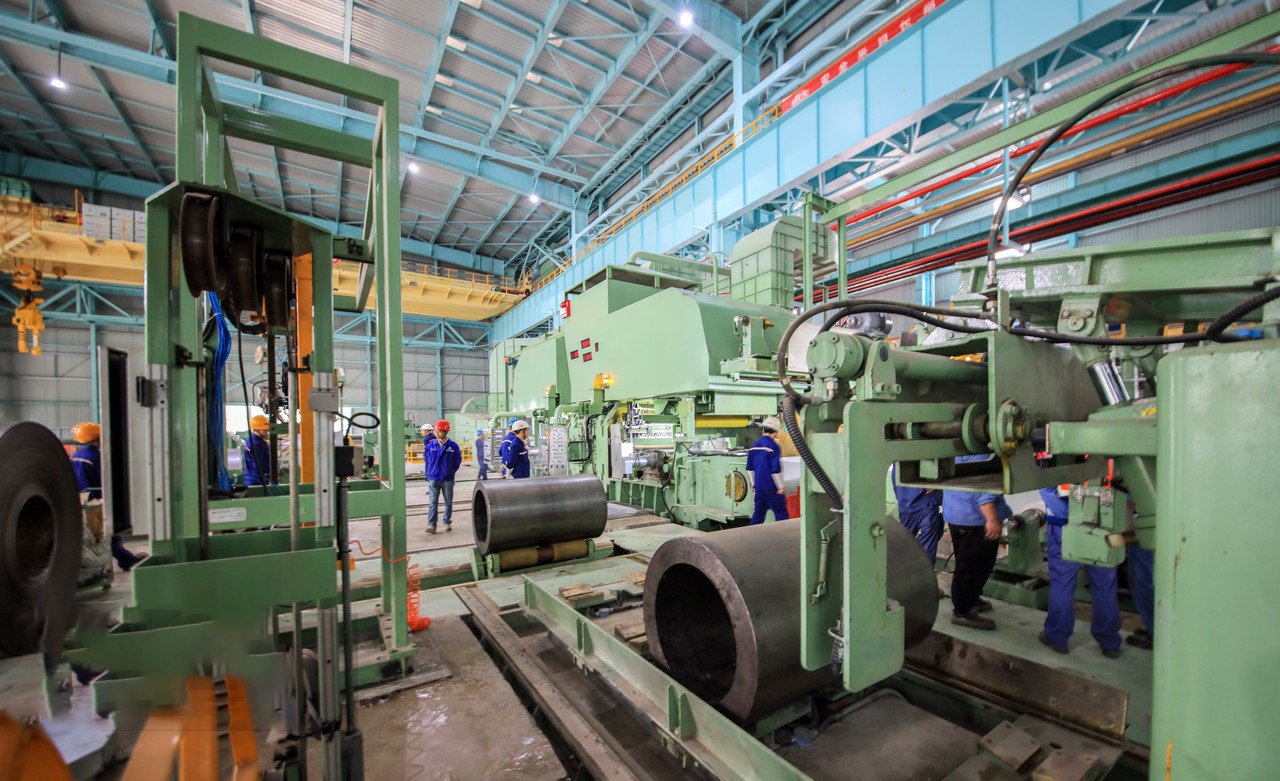
To truly grasp the essence of stainless steel 304, we must dissect its properties beyond a superficial level. It’s a material forged by a precise combination of elements, each contributing to a whole that is greater than the sum of its parts. This synergy is what allows it to be shaped into everything from delicate medical instruments to massive industrial tanks. By examining its chemical makeup, mechanical capabilities, and physical attributes in detail, we can build a comprehensive understanding of why stainless steel 304 performs so consistently2 across such a broad spectrum of uses.
The Chemical Composition: A Foundation of Strength and Resistance
The secret to 304 stainless steel begins at the atomic level. Its nominal composition of 18% chromium and 8% nickel is the source of its fame, often referred to as 18/8 stainless steel. The chromium is the primary hero against corrosion. When exposed to oxygen, it forms a thin, stable, and invisible layer of chromium oxide ($Cr_2O_3$) on the surface. This passive film is the material's shield, protecting the iron content from rusting and self-healing almost instantly when scratched. I recall a project supplying coils for architectural panels on a commercial building in a non-coastal city. The client was debating between galvanized steel and SS 304. We demonstrated that while the upfront cost of 304 was higher, the passive layer’s self-healing nature meant it would never require repainting and would resist urban pollutants far more effectively, ensuring the building's facade remained pristine for decades.
The nickel content is equally crucial, though its role is more about structure and formability. Nickel acts as an austenite stabilizer, which means it keeps the steel in a non-magnetic, highly ductile crystalline structure from high temperatures down to cryogenic levels. This austenitic structure is what gives 304 its exceptional toughness and makes it incredibly easy to form. Without nickel, the steel would be ferritic or martensitic—stronger, perhaps, but far more brittle and challenging to shape. This is why 304 is the go-to choice for products requiring significant deep drawing, like the single-piece construction of high-quality kitchen sinks or complex automotive parts.
ly, the low carbon content (typically below 0.08%) plays a vital role in maintaining corrosion resistance, particularly after welding. When stainless steel with higher carbon content is heated (for example, during welding), chromium can combine with carbon to form chromium carbides along the grain boundaries. This process, known as sensitization, depletes the chromium from the surrounding area, making the steel susceptible to intergranular corrosion. By keeping the carbon content low, 304 minimizes this risk, ensuring that welded joints remain as corrosion-resistant as the parent metal. This is a critical factor for our clients in the construction and equipment integration sectors, who rely on the integrity of welded structures.
Mechanical Properties: Balancing Formability and Durability
While chemistry provides the potential, mechanical properties define what a manufacturer can actually do with the material. Stainless steel 304 exhibits a remarkable balance between strength and ductility. Its typical tensile strength is around 515 MPa (75,000 psi), and its yield strength is about 205 MPa (30,000 psi). More impressively, its elongation can exceed 60%, meaning it can be stretched, bent, and formed significantly without fracturing. This high elongation is a direct result of its austenitic structure and is a key reason for its manufacturing versatility.
A perfect case study is a client of MFY who manufactures high-end cookware. They need to press a flat coil into a deep pot shape in a single operation. This deep drawing process requires a material that can stretch uniformly without thinning excessively or cracking under stress. The high elongation and moderate yield strength of 304 are ideal for this. Furthermore, 304 has a high work-hardening rate. As it is cold-worked (bent, pressed, or rolled), its crystal structure deforms, and it becomes significantly harder and stronger. This means the finished pot is much more durable and resistant to dents than the original flat coil it was made from, a property our client leverages to market the longevity of their products.
To put its properties in perspective, a comparison with other common grades is useful. While grade 316 offers superior corrosion resistance due to molybdenum, it is also more expensive and slightly less formable. Grade 430, a ferritic stainless steel, is cheaper and offers decent corrosion resistance but lacks the ductility and formability of 304, making it unsuitable for deep-drawing applications. This balance places 304 in a sweet spot for a vast number of applications where extreme corrosion resistance is not required, but excellent formability and solid durability are paramount.
| Property | Stainless Steel 304 | Stainless Steel 316 | Stainless Steel 430 |
|---|---|---|---|
| Tensile Strength (MPa) | ~515 | ~515 | ~450 |
| Yield Strength (MPa) | ~205 | ~205 | ~205 |
| Elongation (%) | ~60% | ~40% | ~22% |
| Key Alloying Element | 18% Cr, 8% Ni | 18% Cr, 10% Ni, 2% Mo | 17% Cr, 0% Ni |
| Primary Advantage | Versatility, Formability | Enhanced Corrosion Resistance | Cost, Magnetism |
Physical Attributes: Aesthetics, Hygiene, and Performance
Beyond its chemical and mechanical traits, the physical attributes of 304 contribute significantly to its widespread use. One of the most valued is its aesthetic appeal. Stainless steel 304 can be produced with a wide range of surface finishes, from a dull, matte 2B finish to a highly reflective Bright Annealed (BA) or a brushed No. 4 finish popular in architectural and appliance applications. At MFY, we work closely with clients to select the precise finish that meets both their manufacturing process requirements and the aesthetic demands of their end product. This versatility allows it to be both a hidden structural component and a primary, visible design element.
Hygiene is another critical physical attribute. The surface of 304 is non-porous, incredibly smooth, and easy to clean, which prevents the harboring and growth of bacteria. This makes it the default material for industries where sanitation is non-negotiable, such as food and beverage, pharmaceuticals, and commercial kitchens. It does not impart any flavor or color to the products it comes in contact with and can withstand the harsh cleaning chemicals and high-temperature sterilization processes used in these sectors. This hygienic quality is not just a feature; it's a requirement mandated by health and safety regulations worldwide.
ly, its performance at temperature extremes is a noteworthy physical property. As mentioned, its austenitic structure gives it excellent toughness even at cryogenic temperatures, making it suitable for applications involving liquefied gases. Conversely, it also exhibits good oxidation resistance at elevated temperatures, maintaining its strength up to around 870°C (1600°F). While it's not designed for high-temperature structural applications like specialized alloys, this range covers the operating conditions of many industrial processes and consumer applications, such as automotive exhaust components and heat exchangers, further cementing its position as the industry’s most trusted and versatile stainless steel coil.
304 contains 18% chromiumTrue
The chromium content forms a protective oxide layer that gives 304 its corrosion resistance.
304 is magneticFalse
304's austenitic structure makes it non-magnetic in its annealed state.
What factors contribute to the popularity of stainless steel coil 304 in various industries?
Have you ever wondered why stainless steel 304 appears in everything from skyscrapers to kitchen spoons? Relying on a material just because it's popular can be a risky strategy if you don't understand the reasons. Let's uncover the core factors that have cemented its status as an industrial staple.
The popularity of stainless steel coil 304 is driven by its exceptional balance of cost-effectiveness against its long-term performance. Its inherent corrosion resistance, excellent formability, aesthetic versatility, and a mature, reliable global supply chain make it the most practical and efficient choice for countless applications.
This balance between cost and performance is the commercial heartbeat of 304's success. It’s a story I see play out constantly with my clients. I was recently working with a large-scale construction contractor in the Middle East responsible for a new public transit system. They were initially tempted by the lower upfront cost of a lesser material for fittings and railings. However, we sat down and modeled the total cost of ownership. We factored in the maintenance, cleaning, and eventual replacement cycle in their climate. The data was clear: the longevity and low maintenance of 304 would save them millions over the project's lifespan. They chose 304 not because it was popular, but because it was the most economically sound decision. This kind of value proposition, rooted in a blend of tangible performance and supply chain reality, is what truly fuels its global dominance.
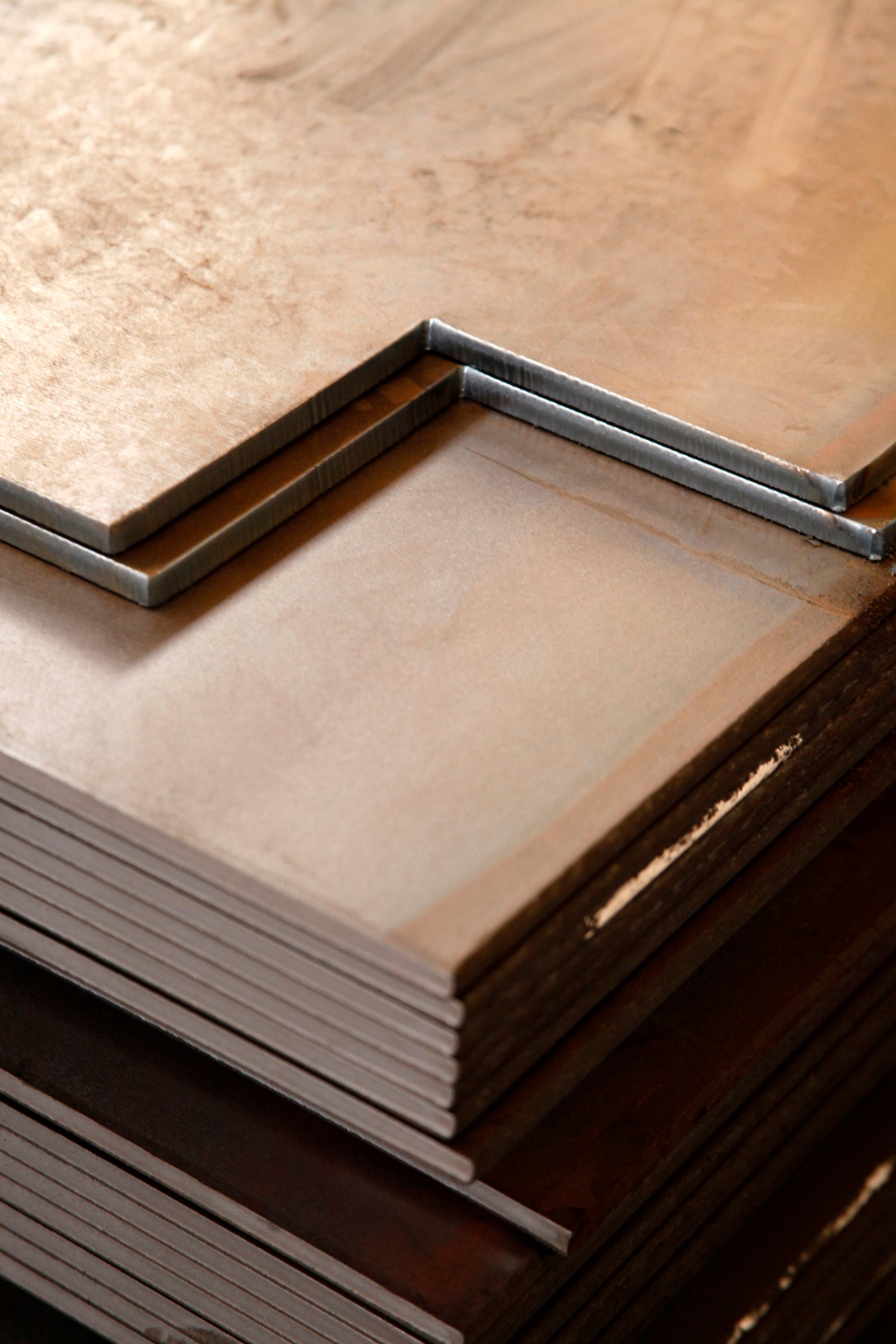
The widespread adoption of stainless steel 304 is not a matter of chance or trend. It is the logical outcome of a powerful convergence of economic, logistical, and fabrication-related advantages. Industries operate on efficiency, reliability, and return on investment. Grade 304 delivers on all three fronts in a way that few other materials can. Its popularity is a testament to a robust value proposition that has been tested and proven over decades in the most demanding environments. Analyzing these contributing factors reveals a blueprint for how a material becomes a global standard, offering lessons in supply chain dynamics, manufacturing efficiency, and long-term asset management.
The Economics of Performance: A Cost-Benefit Analysis
The most compelling factor behind 304's popularity is its exceptional total cost of ownership (TCO). While the initial purchase price of a 304 coil is higher than that of carbon steel or aluminum, its lifecycle value is vastly superior in many applications. The primary economic benefit comes from its durability and long-term performance3, which drastically reduce or eliminate maintenance, repair, and replacement costs. Consider a chemical storage tank. A carbon steel tank might be cheaper to build, but it will require regular painting, inspection for rust, and will likely need to be replaced multiple times within the lifespan of a single, well-maintained SS 304 tank. The savings in downtime, labor, and material for replacement far outweigh the initial cost difference.
This economic calculation is a core part of our consultation process at MFY. We help manufacturing clients analyze not just the cost per kilogram of steel, but the cost per year of service for their final product. For a distributor, this translates to a product that is easier to sell, with a clear value story of longevity. For an engineering contractor, it means reduced risk and a more durable final project that enhances their reputation. According to industry studies, the TCO for stainless steel components in corrosive environments can be up to five times lower than for painted carbon steel over a 30-year period. This powerful economic argument is the number one reason for its specification in infrastructure, industrial equipment, and high-quality consumer goods.
Furthermore, the material's longevity has significant sustainability implications, which are increasingly tied to economic decisions. Using a material that lasts longer reduces the consumption of resources, lowers energy expenditure on manufacturing replacements, and minimizes waste. As companies face growing pressure to adopt more sustainable practices, the extended lifespan of 304 makes it an economically and environmentally sound choice. This "green" dividend, combined with its high recyclability rate (over 90% of stainless steel is recycled at the end of its life), adds another layer to its compelling economic profile.
Supply Chain Maturity and Global Availability
Popularity breeds availability. Decades of high demand have forged an incredibly mature and efficient global supply chain for stainless steel 304. From mills to service centers to distributors, the infrastructure for producing, processing, and delivering 304 coils is robust and widespread. This has several direct benefits for our clients. Firstly, it leads to relative price stability compared to more exotic alloys that are subject to volatile raw material costs and limited production capacity. Secondly, it ensures high availability of stock in a vast range of sizes, thicknesses, and finishes.
As a company with a fully integrated supply chain, MFY leverages this global maturity to our clients' advantage. We can source raw materials competitively and maintain substantial inventory, allowing us to offer [rapid export delivery](Understand the role of supply chain in stabilizing stainless steel 304 supply)4 to our key markets in India, Southeast Asia, and Russia. I once worked with an equipment integrator who secured a large, time-sensitive contract. They needed a significant quantity of 304 coils with a specific width and finish delivered within a tight deadline. Because of the mature supply chain and our own deep inventory, we were able to process and ship the material in a fraction of the time it would have taken for a less common alloy, enabling our client to meet their production schedule and avoid penalties.
This logistical advantage cannot be overstated. For manufacturing companies running lean, just-in-time production schedules, knowing that a reliable supply of their primary material is readily available is a massive strategic benefit. It reduces their need to hold large, costly inventories and minimizes the risk of production stoppages due to material shortages. The global ecosystem of expertise, from metallurgists to fabricators, also means that technical support and processing knowledge are widely accessible, lowering the barrier to entry for companies looking to incorporate 304 into their products.
Versatility in Fabrication: The Manufacturer's Ally
A material is only useful if it can be efficiently transformed into a finished product. Stainless steel 304 is exceptionally friendly to a wide range of fabrication processes, a key reason for its popularity among manufacturers. Its ductility and low work-hardening rate (compared to other stainless grades) make it easy to form, bend, stamp, and deep draw. This reduces the energy required for forming operations, minimizes tool wear, and allows for the creation of complex geometries with fewer steps, all of which lower production costs.
Weldability is another critical factor. Grade 304 can be readily welded using all standard fusion and resistance welding techniques. Its low carbon content prevents the problematic carbide precipitation during welding, ensuring that the corrosion resistance of the heat-affected zone remains intact. This is a significant advantage over other alloys that may require pre-heating or post-weld heat treatment to restore their properties, adding complexity and cost to the manufacturing process. We often supply coils to manufacturers of stainless steel pipes and tubes, where weld integrity is paramount. The reliable and predictable welding performance of 304 is fundamental to their entire business model.
This ease of fabrication extends to finishing processes as well. It can be easily polished, brushed, or embossed to achieve desired aesthetic effects. This versatility makes it a favorite among designers and architects. For a manufacturer, this means a single base material can be used to produce a variety of product lines with different looks and feels, simplifying inventory and purchasing. The combination of easy forming, welding, and finishing makes 304 a true manufacturer's ally, reducing production bottlenecks and enabling the efficient creation of high-quality, durable, and attractive goods.
304 has lower total cost than carbon steelTrue
Despite higher initial cost, 304's durability and corrosion resistance lead to lower maintenance and replacement costs over time.
304 is difficult to weldFalse
304 has excellent weldability with standard techniques and doesn't require special pre/post treatments like some other alloys.
How does stainless steel coil 304 perform in terms of corrosion resistance and durability?
The term "corrosion-resistant" is often used, but what does it really mean in practice? Assuming a material is invincible in all conditions can lead to unexpected and costly failures. We need to look honestly at the performance limits and true durability of stainless steel 304.
Stainless steel 304 provides excellent corrosion resistance to most oxidizing acids, atmospheric conditions, and sterilizing solutions. Its durability is high due to its toughness and work-hardening properties. However, it is susceptible to pitting and crevice corrosion in environments containing chlorides, such as coastal and marine applications.
This distinction regarding chloride environments is absolutely critical. I can't count the number of times I’ve consulted on a project where this very issue was the central point of failure. A few years ago, a potential client approached us after experiencing significant issues with architectural railings they had installed in a coastal resort. They used 304, assuming "stainless" meant stain-proof everywhere. Within a year, tea-staining and pitting corrosion were rampant due to the constant exposure to salt spray. This was a classic case of misapplication. It wasn't a failure of the material, but a failure to understand its specific boundaries. By switching to grade 316, which contains molybdenum specifically to resist chlorides5, the problem was solved for future installations. This story underscores the need to move beyond marketing slogans and develop a nuanced, practical understanding of a material's true performance envelope, which is precisely what we will do now.
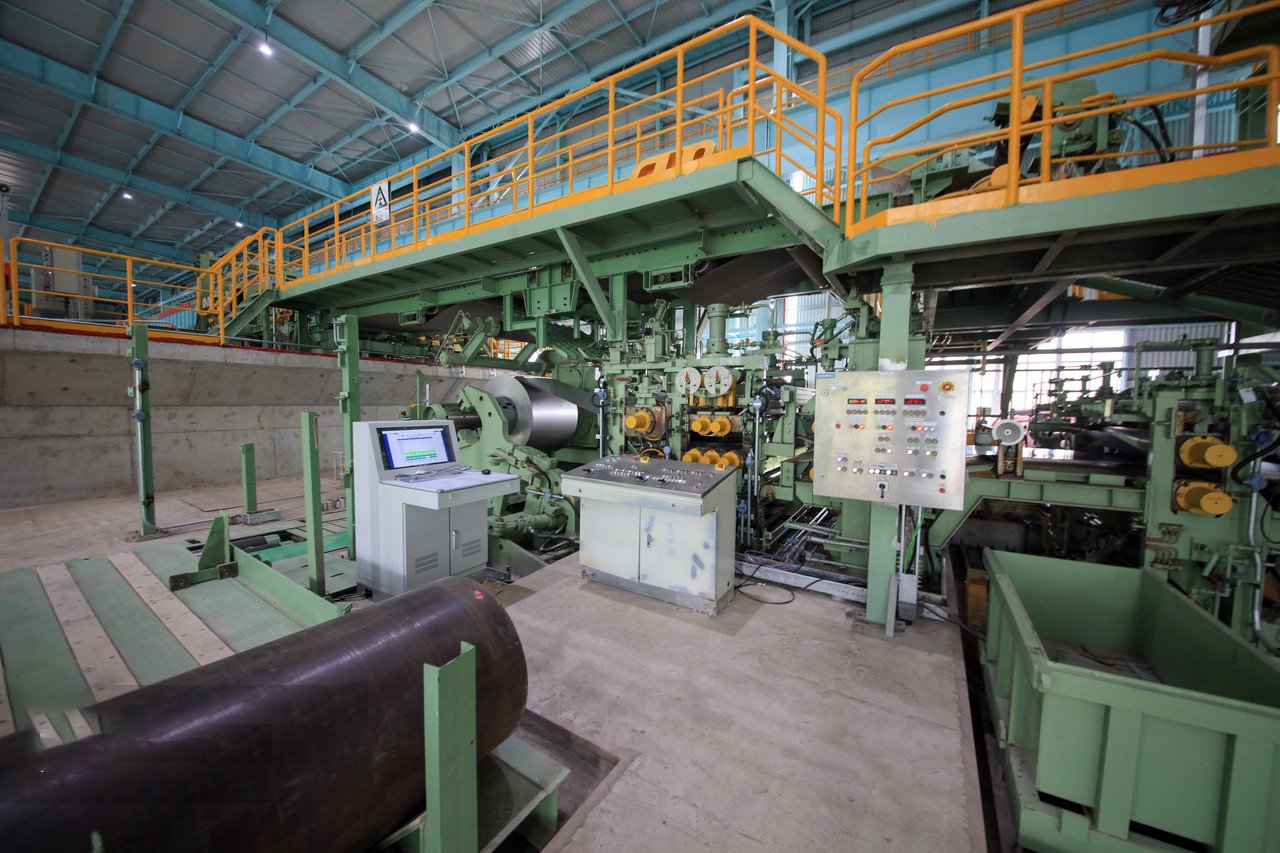
Durability is a multifaceted concept, encompassing not just resistance to chemical degradation but also the ability to withstand mechanical stress and wear over time. The reputation of stainless steel 304 is built on a solid foundation of performance in both these areas. However, a professional and critical analysis requires us to examine the mechanisms behind its resilience and, just as importantly, to clearly define its operational boundaries. Understanding the science of its protective layer, its specific vulnerabilities, and its mechanical toughness is essential for any engineer or manager aiming to build products that are safe, reliable, and built to last.
The Science of Passivation: The Invisible Shield
The primary reason stainless steel 304 resists corrosion is not because it is inherently unreactive, but because it protects itself with a remarkable defense mechanism. This is the science of passivation. As I mentioned earlier, the chromium in the alloy (a minimum of 10.5% is required for a steel to be "stainless") reacts with oxygen in the air or water to form a very thin, tough, and transparent layer of chromium oxide ($Cr_2O_3$). This passive film is only a few nanometers thick, yet it is incredibly effective at isolating the underlying steel from corrosive environments. It is non-porous and adheres strongly to the steel surface, acting as a complete barrier.
What makes this passive layer so extraordinary is its ability to self-heal. If the surface is scratched, abraded, or cut, the newly exposed chromium almost instantly reacts with oxygen, reforming the protective film. This is a dynamic and continuous process. This contrasts sharply with protective coatings like paint or galvanizing. When a painted surface is scratched, the underlying steel is exposed and begins to rust, with corrosion often creeping under the coating. The self-healing nature of 304's passive layer provides a far more robust and permanent form of protection, which is why it requires no coating and minimal maintenance in suitable environments. Studies from metallurgical research institutes consistently show this film is stable across a wide pH range, making it resistant to common food acids, industrial chemicals, and atmospheric pollutants.
This passivation process is why proper handling is so important. If a 304 surface is contaminated with particles of iron or carbon steel (for example, from grinding sparks or using contaminated tools), these free iron particles will rust on the surface. This is not the stainless steel corroding, but the contaminant. It creates an unsightly stain and can, in severe cases, disrupt the passive layer and initiate localized corrosion. As a responsible supplier, MFY always advises clients on best practices for fabrication and cleaning to ensure the integrity of this vital invisible shield is maintained.
Understanding the Boundaries: When 304 Is Not Enough
No material is perfect for every situation, and the key to effective engineering is knowing a material's limits. The primary Achilles' heel of stainless steel 304 is its vulnerability to chloride ions. Environments rich in chlorides, such as seawater, de-icing salts, and certain industrial chemicals (like hydrochloric acid or bleach), can break down the passive layer in localized spots. This leads to specific forms of corrosion, most notably pitting and crevice corrosion. Pitting is the formation of small, deep holes on the surface, while crevice corrosion occurs in tight spaces where oxygen is restricted, like under bolt heads or in gasket seals.
This is the critical dividing line where grade 316 stainless steel becomes the necessary choice. The addition of approximately 2% molybdenum to grade 316 significantly enhances the stability of the passive film, making it far more resistant to chloride attack. I often use a simple comparison for my clients: for an architectural project in an inland city like Moscow, 304 is a perfect, cost-effective choice. For an identical project in a coastal city like Mumbai or a location that uses de-icing salts heavily, 316 is a mandatory specification. Choosing 304 in the latter case is inviting premature failure. This isn't a defect in 304; it's a fundamental property that must be respected in the design phase.
It's also important to consider temperature and concentration. A dilute, cool chloride solution may have little effect on 304, but as the temperature and concentration of the chlorides increase, the risk of corrosion rises dramatically. This is a critical consideration for our clients in the chemical processing and equipment integration sectors. We work with them to review their process chemistry and operating temperatures to ensure the grade of steel selected provides a sufficient safety margin. Our role at MFY is not just to sell steel, but to provide the technical guidance that ensures our clients' projects succeed in the long term.
Durability Beyond Corrosion: Work Hardening and Fatigue Life
The durability of stainless steel 304 extends well beyond its chemical resistance. Its mechanical toughness is a defining feature. As an austenitic steel, it can absorb significant impact energy without fracturing, even at very low temperatures where carbon steels become brittle. This inherent toughness makes it suitable for a wide range of structural and safety-critical applications where impact resistance is a concern.
Furthermore, as previously discussed, 304 exhibits a significant work-hardening (or strain-hardening) effect. When the material is plastically deformed by bending, rolling, or stretching, its crystal structure changes, making it stronger and harder. While this can make extensive machining more challenging, it is a highly desirable property in many applications. For example, a manufacturer of stainless steel conveyor belts relies on this property. The cold-rolling process used to form the belt material increases its tensile strength, resulting in a finished product that is highly resistant to stretching and wear during operation. The work-hardened surface is also more resistant to abrasion and scratching.
ly, 304 possesses good fatigue strength. Fatigue is the failure of a material under repeated or cyclic loading, even at stress levels far below its ultimate tensile strength. The fine-grained austenitic structure of 304 is effective at resisting the initiation and propagation of fatigue cracks. This makes it a reliable choice for components subjected to vibration or cyclical stress, such as springs, flexible connectors, and certain types of machine mounts. This combination of corrosion resistance, impact toughness, work-hardening capability, and good fatigue life creates an overall profile of exceptional durability that few other materials can offer at a comparable price point.
304 resists most oxidizing acidsTrue
Stainless steel 304's chromium oxide layer provides excellent resistance to oxidizing acids like nitric acid, making it suitable for chemical processing equipment.
304 is immune to all chloridesFalse
304 is vulnerable to pitting corrosion in chloride-rich environments like seawater, requiring upgrade to 316 for such applications.
What applications are ideal for stainless steel coil 304 in the manufacturing sector?
Knowing a material's properties is theory; knowing where to apply it is what drives success. Using a high-quality material in the wrong application is a waste of its potential and your budget. Let's identify the sweet spots where stainless steel 304 truly shines in manufacturing.
Ideal applications for stainless steel coil 304 are concentrated in sectors where a combination of hygiene, formability, and good general corrosion resistance is required. This includes food processing equipment, kitchen appliances, architectural panels and trim, automotive components, and chemical storage tanks.
The next time you walk through a modern city or a factory, take a closer look. The gleaming kitchen exhaust hoods in a restaurant, the robust fermentation tanks in a brewery, the sleek trim on a skyscraper, and the intricate piping in a pharmaceutical plant are all prime examples of 304 at work. This ubiquity is the result of decades of proven performance. I recently oversaw a large shipment of 304 coils to a major food and beverage conglomerate in Southeast Asia for a new factory build-out. Every piece of equipment that would touch the product, from mixing vats and piping systems to conveyor belts and work surfaces, was specified as grade 304. This wasn't a choice made on a whim; it was a strategic decision based on global standards for hygiene, durability, and long-term value6. This single project perfectly captures the material's ideal use cases, which we will now explore in specific detail.

To truly appreciate the role of stainless steel 304, we must move from generalities to specific, high-impact applications. Its selection in any given sector is not arbitrary but is based on a precise alignment of its inherent properties with the specific demands of that industry. Whether the primary driver is sanitation, aesthetic longevity, or manufacturability, 304 consistently provides an optimal solution. By examining its role in key sectors like food processing, architecture, and automotive manufacturing, we can see a clear pattern of how its unique blend of characteristics translates into tangible, real-world value.
Food & Beverage and Pharmaceutical Industries: The Hygienic Standard
In industries where cleanliness is paramount, stainless steel 304 is not just an option; it is the global standard. Its surface is non-porous, crevice-free, and highly resistant to corrosion from the acids, alkalis, and chlorides found in food products and cleaning agents. This smooth, inert surface does not harbor bacteria or other pathogens, making it incredibly easy to clean and sterilize. This is why it is the material of choice for virtually all food and beverage contact surfaces, including storage tanks, vats, piping systems, preparation tables, and processing machinery.
At MFY, we supply a significant volume of 304 coils to manufacturers of dairy equipment. This is an industry with some of the most stringent sanitary requirements. Our client requires coils with a No. 4 brushed or 2B matte finish, as these surfaces have a proven low bacterial retention and are easily cleaned using Clean-in-Place (CIP) systems. The material must withstand daily cycles of thermal stress and exposure to strong cleaning chemicals without degrading. The reliable performance of 304 ensures that our client's equipment can meet international food safety standards, like those from the NSF and 3-A Sanitary Standards, which is critical for their ability to export their products globally.
The same principles apply to the pharmaceutical industry. The need for a sterile, non-reactive surface is a matter of public health and regulatory compliance. Stainless steel 304 is used extensively for mixing vessels, dryers, piping, and other equipment involved in drug manufacturing. Its ability to maintain its integrity and not leach any substances into the product ensures the purity and safety of the final medicine. The combination of its hygienic properties, good chemical resistance, and cost-effectiveness makes it the workhorse material for the infrastructure of these vital industries.
Architecture and Construction: Aesthetic Appeal Meets Longevity
In the world of architecture and construction, materials must satisfy a dual mandate: they must be durable enough to withstand the elements and aesthetically pleasing enough to realize the architect's vision. Stainless steel 304 excels on both fronts. Its clean, modern luster and ability to be formed into a wide array of finishes—from mirror-polished to satin-brushed to embossed patterns—provide immense design flexibility. It is used extensively for exterior facades, roofing, wall panels, column covers, and decorative trim.
A prime case study is the use of 304 for building facades in major urban centers (away from direct coastal exposure). I worked with a construction contractor on a high-profile office tower project. They chose MFY's 304 coils with a No. 4 finish for the exterior cladding. The material offers excellent resistance to the corrosive effects of urban pollution and acid rain. Unlike painted steel, it will not chip or fade, and unlike aluminum, it has superior resistance to scratches and dents. The result is a building that will maintain its striking appearance for decades with only minimal periodic cleaning, drastically reducing long-term maintenance costs and preserving the property's value.
Beyond facades, 304 is ubiquitous in interior applications as well. It's the standard for elevator panels, escalators, handrails, and kick plates—areas that require high durability and wear resistance while maintaining a clean, high-end look. Its fire and heat resistance also contribute to its specification in public buildings, as it will not produce toxic fumes in a fire. In construction, 304 provides a solution that is at once practical, beautiful, and enduring.
Automotive and Transportation: A Balance of Form, Function, and Cost
The automotive industry is a relentless pursuit of performance, efficiency, and cost optimization. Stainless steel 304 has carved out a crucial niche by offering a balanced solution for various components. One of its most common applications is in vehicle exhaust systems, including mufflers, resonators, and tailpipes. While high-end performance cars may use more exotic alloys for the hottest parts of the system, 304 provides an ideal combination of heat resistance, corrosion resistance (against road salt and condensation), and formability for the majority of the system, at a much lower cost than higher-nickel alloys.
We have a long-standing partnership with an automotive parts supplier who manufactures exhaust components for several major brands. They rely on MFY for a steady supply of 304 coils with very specific temper and thickness tolerances. The material must be ductile enough to be bent into complex pipe shapes and formed into muffler bodies, yet strong enough to withstand the vibrations and thermal cycling of daily driving. The reliable weldability of 304 is also critical for their automated assembly lines. By providing consistent, high-quality material, we help them maintain their production efficiency and meet the stringent quality demands of the automotive OEMs.
Beyond exhaust systems, 304 is also used for automotive trim, grilles, and wheel covers where a bright, durable, and rust-free appearance is desired. In the broader transportation sector, it's used in the construction of tanker trucks for transporting food-grade liquids and chemicals, as well as for structural components in buses and rail cars. In every case, the story is the same: 304 is chosen because it provides the required performance and manufacturability in the most economically efficient package.
304 is ideal for food processingTrue
Stainless steel 304's non-porous surface and corrosion resistance make it perfect for hygienic food contact surfaces.
304 is unsuitable for coastal facadesFalse
While 316 is preferred for direct coastal exposure, 304 performs well in urban environments away from saltwater.
What are the expert recommendations for sourcing and utilizing stainless steel coil 304 effectively?
You've decided that 304 is the right material. The job isn't done yet. Sourcing from an unreliable supplier or using improper fabrication techniques can negate all the material's benefits, leading to quality issues, delays, and hidden costs. Let's cover the expert strategies for success.
Experts recommend partnering with a supplier who provides complete Mill Test Certificates (MTC) for traceability and has an integrated supply chain. It is crucial to specify the exact finish and temper for your application and to follow best practices in handling to prevent contamination.
This advice comes from hard-won experience. I'll never forget a call from a frantic new client. They had sourced a batch of what was sold as "304 coil" from a trader based solely on the lowest price. Their stamping process was failing, with some parts cracking and others forming inconsistently. When we analyzed the material, we found wild variations in chemical composition and thickness from one end of the coil to the other. Their pursuit of a small upfront saving had cost them tens of thousands in downtime and wasted material. This cautionary tale is why I am so passionate about educating our clients. The "how" and "from whom" of sourcing are just as critical as the "what." This section will distill my years of experience at MFY into actionable advice to protect your investment and ensure your project's success.
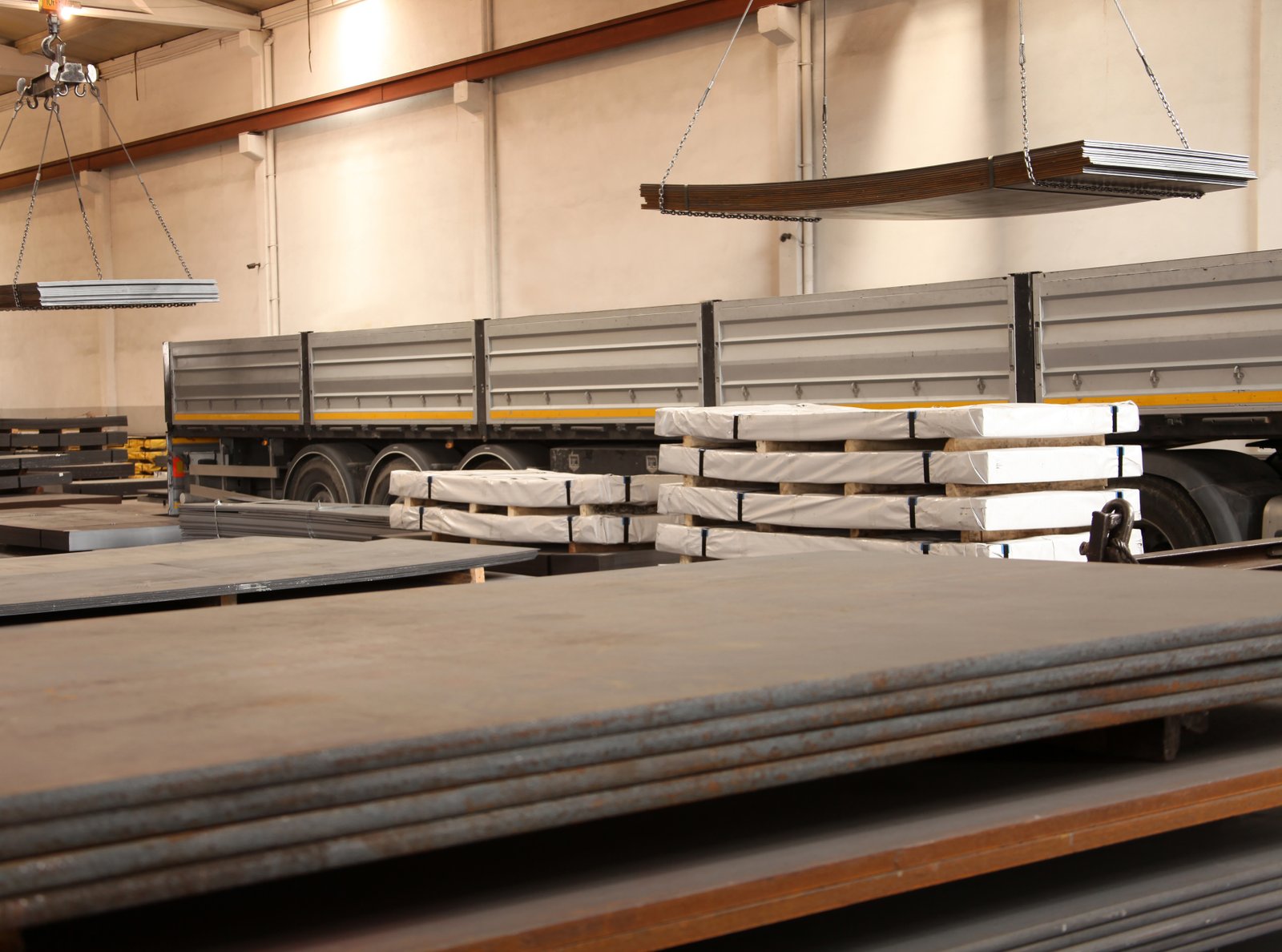
Effectively leveraging stainless steel 304 is a two-part process: intelligent procurement followed by meticulous execution. Simply placing an order is not a strategy. A strategic approach to sourcing and utilization mitigates risk, ensures consistency, and ultimately extracts the maximum value from the material. This involves a shift in perspective—viewing your supplier not as a mere vendor, but as a strategic partner in your manufacturing process. It also requires an internal commitment to quality control and proper handling procedures. By focusing on these critical areas, you can transform a simple coil of steel into a reliable foundation for your business's success.
The Critical Role of a Reliable Supplier: Beyond the Price Tag
The single most important decision you will make is choosing your supplier. A reliable supplier is more than just a box-shifter; they are your first line of defense in quality control. The first thing to demand for every coil is a complete Mill Test Certificate (MTC)7 or Material Test Report (MTR). This document is the material's birth certificate, providing a detailed chemical analysis and breakdown of its mechanical properties. It is your only true guarantee that the steel you are receiving is genuine grade 304 and meets the standards you require. A supplier who cannot or will not provide a clear, traceable MTC should be avoided at all costs.
Beyond documentation, consider the supplier's structure. At MFY, our fully integrated supply chain8—from raw material trading and cold-rolling to export logistics—provides a significant advantage. It gives us unparalleled control over quality and consistency at every step of the process. This integration means we can guarantee the material's provenance and ensure that the coil delivered to your facility has the exact properties you specified. This contrasts with a simple trading company that may be sourcing from various unknown mills, introducing a high degree of variability. A supplier with deep inventory and processing capabilities can also offer services like slitting coils to a precise width or applying protective coatings, saving you time and production steps.
ly, a quality supplier acts as a technical resource. Your relationship should be a partnership. They should have knowledgeable staff who can discuss your application, help you troubleshoot fabrication issues, and advise on the best grade or finish for a new product. This collaborative approach ensures you are not just buying a product, but gaining a competitive edge. Look for suppliers with a track record of success, strong client testimonials, and a clear commitment to quality, such as ISO 9001 certification.
Specification is Key: Getting Exactly What You Need
Ordering "stainless steel 304 coil" is not specific enough. To ensure you get the right material for your job, you must be precise in your specifications. The most common variables to define are the surface finish, the temper (or hardness), and the dimensional tolerances. Each of these will have a direct impact on your manufacturing process and the quality of your final product. Forgetting this step is a common but costly mistake.
A case in point: we worked with an equipment integrator in India that uses a roll-forming process to create complex profiles for their machinery. They were experiencing issues with cracking. After reviewing their process, we realized they were using a standard annealed temper coil. We recommended they switch to a 304 coil with a slightly softer temper, specifically processed for severe forming operations. The change was implemented, and their rejection rate dropped to nearly zero. This highlights the importance of matching the material's properties to the specific fabrication method.
The table below outlines some common finishes and their typical applications, illustrating why specification is so important. A manufacturer of high-end appliances will need a different finish than a manufacturer of industrial tanks. Clearly communicating these requirements to your supplier is essential.
| Finish | Description | Typical Applications |
|---|---|---|
| No. 1 | Hot-rolled, annealed, and pickled. A dull, rough surface. | Industrial applications where finish is not important. Structural parts, furnace parts. |
| 2B | Cold-rolled, annealed, pickled, and skin-passed. Smooth, moderately reflective matte finish. | Most common finish. Food processing equipment, chemical tanks, cookware. |
| BA | Bright Annealed. Cold-rolled and annealed in a controlled atmosphere. Highly reflective, mirror-like. | Architectural trim, mirrors, reflectors, appliances where high aesthetic value is desired. |
| No. 4 | General purpose polished finish (brushed). Unidirectional texture, not highly reflective. | Kitchen sinks, appliances, dairy equipment, architectural panels, handrails. |
Best Practices in Handling and Fabrication: Preserving Integrity
Once the correctly specified material arrives at your facility, your team's handling and fabrication practices become critical. The excellent properties of stainless steel 304 can be compromised by improper techniques. The most important rule is to avoid cross-contamination with carbon steel. Designate specific tools (grinders, brushes, clamps) for stainless steel use only. Grinding sparks from carbon steel can embed iron particles into the stainless surface, which will then rust and disrupt the passive layer. Similarly, storing stainless steel coils or sheets in an area where they can be contaminated by carbon steel dust should be avoided.
When welding, it is crucial to use the correct filler metals (typically ER308L) to maintain the low-carbon and corrosion-resistant properties of the weld joint. The "L" designation signifies low carbon, which provides extra assurance against carbide precipitation. After welding or any heavy fabrication, the area may need to be cleaned and "re-passivated." This can involve using a pickling paste to remove heat tint (the discolored area near a weld) and a passivating acid bath (like nitric acid) to help rapidly reform a robust chromium oxide layer, restoring maximum corrosion resistance.
Proper storage and handling are also key. While durable, the surface finish can be scratched. For aesthetic applications, keeping the protective film on the coil for as long as possible during the fabrication process is a best practice. By investing in training and establishing clear protocols for handling, fabrication, and post-fabrication cleaning, you ensure that the integrity of the material is preserved all the way through to the final product. This diligence protects your investment and delivers the performance your customers expect.
MTC guarantees 304 authenticityTrue
Mill Test Certificates provide verified chemical/mechanical data proving the material meets 304 specifications.
Price alone determines qualityFalse
The cheapest 304 coils often lack proper certifications and consistent properties, leading to fabrication failures.
Conclusion
Ultimately, stainless steel coil 304 is the industry's indispensable workhorse for a reason. Its value is unlocked by understanding its balanced properties, applying it to the right jobs, and sourcing it from a reliable partner who guarantees quality and provides technical support.
-
Discover the versatility and traits that make 304 stainless ideal for various applications. ↩
-
Learn the detailed analysis of 304's properties to understand its wide-ranging applications. ↩
-
Discover the factors contributing to the cost-effectiveness of stainless steel 304 ↩
-
Understand the role of supply chain in stabilizing stainless steel 304 supply ↩
-
Understand the role of molybdenum in enhancing chloride resistance of stainless steel 316 ↩
-
Learn how global standards ensure the safety and durability of food processing equipment. ↩
-
Learn how MTCs ensure quality and traceability in steel sourcing. ↩
-
Understand the benefits of an integrated supply chain for consistency and reliability. ↩
Have Questions or Need More Information?
Get in touch with us for personalized assistance and expert advice.

